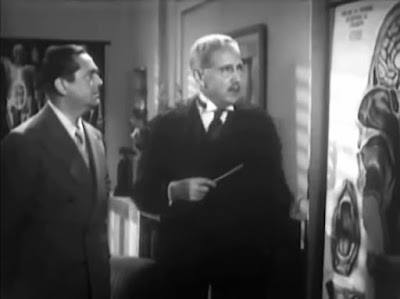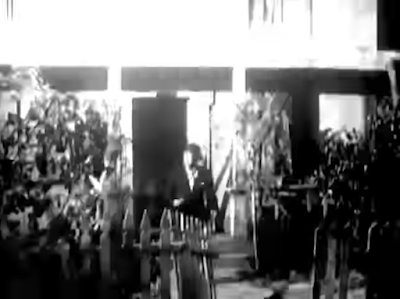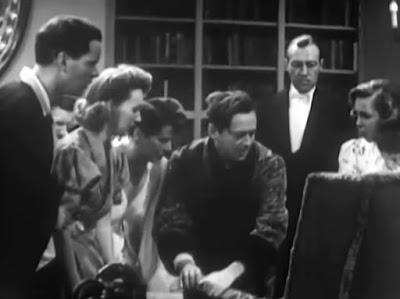Is he dead? Is he alive? Or is he caught in a waking nightmare too terrible to describe? Grab yourself a cup of cocoa and a stethoscope as we prepare to examine 1942's THE LIVING GHOST!
Oh, what to do with this one? Is it an Old Dark House movie? Is it even spooky? The title isn't really helping matters (and neither are those ghost-themed opening credits) because here we have a more-or-less straightforward whodunit, complicated not by supernatural elements but by a dash of pseudo-science involving paralysed brain cells.
Let's try and untangle a couple of other things too: the source of the mystery here isn't actually a murder (at least, not to begin with) but a kidnapping, leading to a sort of zombification deal whereby the victim - he of the paralysed brain cells - loses the ability to think and speak for himself. (I know, we've all been there.) Zombies were all the rage in early 40s cinema but tended to be linked with voodoo rather than science, which gives this an interesting angle. But does it lead to anything we'd class as zombie horror? Well, interestingly, yes... I'll explain more in a moment, but the main reason I'm including The Living Ghost in our Old Dark House canon is because of an extended plot detour that, as in The Ghost Breakers, comes a little late in the game but definitely takes us into scare territory.
So, who's had their brain cells paralysed and why? Over at the Craig mansion, reporters are clamouring at the door for news on the whereabouts of wealthy old Mr Craig, but it seems that none of the gathered relatives know anything about anything, other than the fact that he's vanished. Ex-detective Nick Trayne (now working, bizarrely, as a 'professional listener' dressed in full swami garb) is called in to investigate, but it's not long before Mr Craig reappears - not dead, not injured, not even reduced to an ear in an envelope, but sitting in his armchair in some sort of trance, barely able to blink, never mind explain what happened.
Nick determines to get to the bottom of things, aided by Mr Craig's young secretary, Billie, who's perhaps worried she'll be out of a job if normality isn't restored sometime soon. Of course, along with their requisite sleuthing, you can expect romance to blossom between this generationally-mismatched duo...
The Living Ghost takes place primarily at two different locations: the bright and pleasant Craig manor (where most of the suspects reside and much of the mystery unfolds) and the derelict 'house on Blakely Road' (as it's referred to in a sort of running joke). The latter is the film's actual Old Dark House, which Nick and Billie explore in a splendid sequence set during a raging storm, with flashes of lightning like nearby explosions practically blasting the actors off their feet. Also roaming the house is another zombified victim - one who's been programmed to kill! The comparatively genteel nature of the rest of the film only adds to the effectiveness of this passage, which also prefigures those famous scenes in 70s gialli like Deep Red, in which protagonists find clues (and worse) in creepy old buildings.
Putting a dampener on things, however, is that aforementioned romance between the leads, which is rammed in like a shoe on a sandwich and looks about as appetising. It's not really the fault of either actor: Joan Woodbury is lively and fun as Billie, while James Dunn (Nick) went on to win an Oscar just three years later for his work in A Tree Grows in Brooklyn. It's just clear that the writers hadn't seen any of the four Thin Man films released by this point, or at least hadn't learned anything about making 'banter' sexy and smart. Instead, Nick's come-ons come off as near-unbearable to modern ears, and the way he 'tests' their relationship borderline abusive. I know you can't judge older films as if they were released recently, but I've seen enough from the 40s to spot the worst offenders - and unfortunately this one's up there!
Thankfully, such moments are relatively brief, and other faces among the cast offer some diversion. Minerva Urecal fills the doomsayer role perfectly ("Hate and death are in this house... If you're wise you'll leave right now!") and the roguish yet dapper George Eldredge is enough to set the heart of any modern hipster a-flutter. The whole thing is clearly influenced by 1939's The Cat and the Canary and its ilk, which if you're anything like me will make it essential viewing. Just be ready to close your eyes and think of Bob Hope!
RATING: 🕸🕸



No comments:
Post a Comment